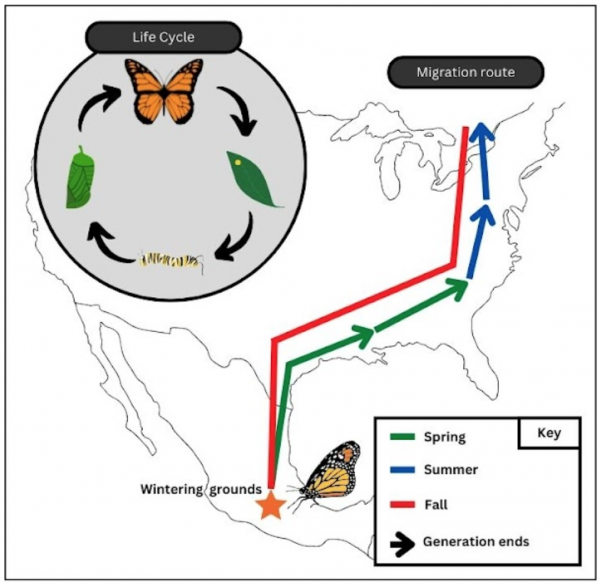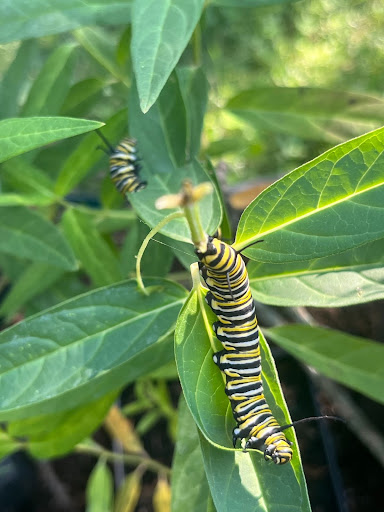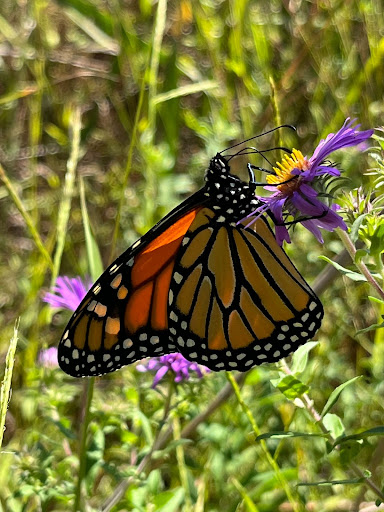Monarch butterflies were added to the endangered species list this year due to their rapidly declining populations.
MONARCH BUTTERFLIES
One of the most famous butterfly species, the Monarch butterfly, is not just known for its iconic orange and black coloration but also their unique life history. These butterflies make some of the most spectacular migrations in the animal kingdom. Starting in their wintering grounds in central Mexico, eastern monarchs begin their migration in spring. They travel north, laying their eggs on native milkweeds along the way. Those eggs hatch into caterpillars uniquely adapted to consume these toxic plants while utilizing the toxins for their own protection. After a few weeks, the caterpillars will make a chrysalis and metamorphosize into an adult butterfly.
The newly emerged butterflies then travel further north, repeating the process for up to four generations until they reach Canada by the end of summer. The last generation of the season is known as the “super generation.” These butterflies are the individuals that travel all the way back to Central Mexico during the fall to overwinter and start the process over next spring. This super generation will live up to 8 times longer and fly 10 times further than their parents, grandparents, and great-grandparents from earlier that season. Unfortunately, as of the past two decades, these incredible butterflies are in danger. With your help and the help of our community, we hope to prevent the decline of Monarch butterflies and ensure their survival for future generations.

MONARCHS IN TROUBLE
Monarch butterflies were added to the endangered species list this year due to their rapidly declining populations. This decline is due to the challenges these charismatic butterflies face during their long migration route, spanning multiple countries. One of the major problems is the reduction in milkweed populations caused by the conversion of land to sterile lawns, paired with the overuse of pesticides. As milkweed plants are the sole food source for Monarch caterpillars, when milkweed populations decline, so does the Monarch habitat. Another factor is the invasive praying mantis species, which are known to feed on adult Monarchs. Data suggests climate change may also be contributing to their decline, as weather changes may be delaying the Monarchs’ migrations. This delay can lower their migration success, as fewer nectar sources (i.e. fuel for their migration) are available later in the fall.
However, there is good news. Multiple organizations (e.g. MonarchWatch and Journey North) are studying the butterflies to help conserve this iconic species. Volunteers all over the country have been monitoring and tagging butterflies on their journey back to Mexico to get a better understanding of their populations, migration patterns, and their habitat.

WHAT CAN YOU DO TO HELP?
If you plant it, they will come…
- Plant native milkweeds (Non-native/ tropical milkweed species are known to harm monarch butterflies rather than help them).
- Reduce your lawn and add native wildflowers. Monarchs also need nectar sources as adults, and a variety of wildflowers that bloom throughout the season is best.
- Manage the invasive praying mantises on your property. The easiest way to do this is to collect their egg sacs before they hatch in spring.
- Join Heritage Conservancy’s community science program and help us tag and monitor Monarchs.

WHAT IS HERITAGE CONSERVANCY DOING TO HELP?
- Heritage Conservancy is creating native wildflower meadows and patches (including milkweeds) at our preserves throughout Bucks County.
- The Community Science program has been tagging butterflies at Jackson Pond preserve for the last two seasons to study their migration routes back to Mexico.
- We grew and donated over 100 milkweed plants to community members to plant on their properties this year.
- Heritage Conservancy educates the public about the importance of pollinators and how to best protect and conserve them for future generations.
Thanks for reading!
Tyler Kovacs, Heritage Conservancy Conservation Steward
